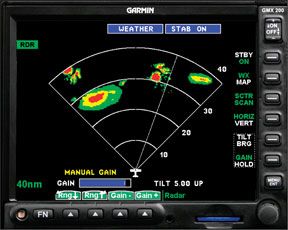In th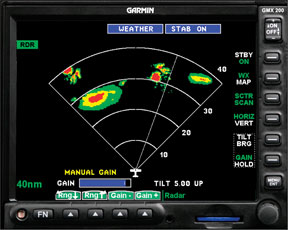
But hold on a second. The microwave-spewing front end of the typical light aircraft radar set can be a forever kind of thing. They were expensive to begin with, but with reasonable maintenance, they work as we’ll as when they were new, so why throw that away? Thats what Avidyne figured out when it went after the niche market of building MFDs compatible with older radar systems. Toss that crummy monochrome radar display and replace it with a color MFD that also displays navigation data and youve instantly got a state-of-the-art panel.
To our surprise, this has rejuvenated and extended the life of ships radar to the point that buyers are actually asking for quotes on new systems. Demand is mostly in the realm of light twins and soon, were told, for the new wave of VLJs, but there are still plenty of wing-mounted single-engine radar sets in service, even if none of those are still in production.
If budget allows and budget usually drives everything owners can enjoy a belt-and-suspenders confidence in weather awareness with datalinked NEXRAD, onboard weather radar and sferics, all wrapped into one display, if you please. But with such redemption come caveats just because you can afford it, doesnt mean you should buy it.
In this article, we’ll outline some smart tips for maintaining and retaining old ships radar, particularly when utilizing the system with a new MFD, a trend that appears to be here to stay.
Radar 101: The Troubleshoot
Radar performance is all about power, antenna size and display. In this regard, light aircraft systems are somewhat hobbled by limited power and small antennas. The smaller the antenna, the more the beam spreads with distance and the less ability the radar has to accurately define a precipitation area. Performance-wise, the 10-inch antenna in a Seneca cant hold a candle to the enormous antenna in a 757. But the addition of datalink radar to the light aircraft cockpit all but erases the advantage of the larger antenna, which cant see as far as NEXRAD under any circumstances.
Component health, particularly power supplies, waveguides, radomes and magnetrons play a role in radar performance, too. Radar, like most analog avionics, consist of many small critical parts and the troubleshooting effort when something goes awry is labor intensive. And it always begins with the pilots description of whats not working, which is sometimes the same as no description at all. All too often the gripe is: “doesnt paint precip.” That alone is sometimes reason enough for owners to remove the radar in favor of datalink.
In our view, there are but a handful of capable shops that can reliably repair broken radar. In our experience, Duncan Avionics a division of the well-established Duncan Aviation Fieldtech Avionics and Honeywell (for Bendix/King and Honeywell radars) are tops for repair work.
Old and New
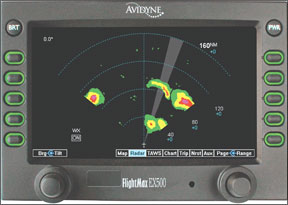
Mating older analog radars with cutting-edge digital color MFD displays is electronically easier than most might believe, thanks to plug-and-play designs that actually work as claimed. Depending on the type of radar, the MFD might have a radar adapter board to accept the proper signal from the radars front end transmitting unit. A pre-manufactured radar adapter harness is usually provided with the MFD to adapt to the old display wiring so if the owner and shop are lucky, the radar components in the nose or pod wont need to be touched.
The task of fitting a new MFD fit into the spot previously occupied by the old display is usually the major challenge. MFDs tend to be physically larger than the radar display so sheet metal work and harness relocation/routing results in extra expense.
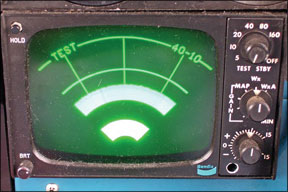
Understandably, owners want a new MFD/radar display to live in the main avionics stack which might not be possible physically in some airplanes, at least within a reasonable budget. Radar/MFD interfaces usually require heading synchronization input for proper weather picture orientation. Since the weather picture is overlaid on the MFDs moving map, its position relative to where the pilot sees it on the map is critical. Without valid and accurate heading input, you can find yourself steering into scary weather with a map that actually appears clear of returns.
The best way to feed the MFD heading is through the HSIs compass system, which might require the installation of an AC inverter, to convert DC voltage into a 400 Hz heading reference. Such voltage conversions can be done for under $1000 while a heading system upgrade will cost many thousands. As a rule, higher-end airplanes are equipped with the heading systems to put the weather display in the proper orientation.
Certs and Paper
The certification paperwork and flight test for calibration could be a source of expense once the interface has been done. If the MFD/radar interface isn’t covered by an AML/STC (Approved Model List Supplemental/Type Certification), FAA field approval is the only route. Were hearing that many FSDOs cant approve such interfaces on a local level and paperwork is sent to upstream FAA offices for time-consuming signoffs.
Some models of radar need in-flight calibration once the MFD has been installed. Such tweaking includes roll and pitch parameter calibration, stabilization adjustments and gain settings, to name a few. In most cases, you wont know how accurate the system will be until you fly it, which means finding some nasty weather to have a look. Luckily, technicians may have a satellite-delivered view of the weather for comparison, thus carrying a Garmin GPSmap 396 on the flight test is a good crosscheck and aid in troubleshooting.
A prudent reminder: Weve seen the sad case of the pilot who left his radar on during taxi in close proximity to metal hangars and caused severe damage to an otherwise healthy system. Be sure to turn the system off when exiting the runway.
Radome Issues
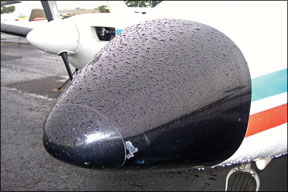
An often forgotten critical component in the radar system is the radome. Get a good look at the radome on some tired twins and you’ll see signs of paint damage and small holes in the surface that can allow water to ingress, trapping moisture that the radar could paint as the real deal. A common complaint among radar users is that the system paints returns in clear weather.
If the radar system components test OK, a hard look at the radome is next. Without the owners knowledge, radomes and the enclosed equipment can take lightning hits when parked on a ramp or in flight. We saw the evidence of a lightning strike on a newer Lear some years ago and it was ugly. We recall the radome on a Beech Baron that had been repaired so many times it had layers of filler so thick even the most powerful of radar couldnt see through it. Once the radome was ultimately replaced, the owner said he was looking at new radar performance.For most small to mid-size twins, nose-located radomes will accommodate a 10-inch radar dish while larger twins and jets can house a more powerful 12-inch unit.
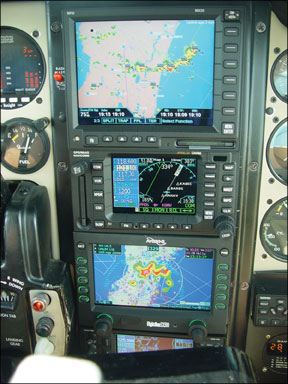
The used radome and radar business from salvage dealers is active and lively, but be careful what you buy, as the radome was likely the first piece of structure to take the impact during a crash, jolting the sensitive radar that lives inside.
Model Review
There are several high-end radar systems suitable for jets and turboprops that we wont address here. Were more interested in models suited for light twins and small turboprops.
Were also arguing that with the advent of state-of-the-art MFD displays, where repairing an older radar might have once been questionable, that may not necessarily be the case today. Is it worth sinking thousands of dollars into equipment that might be 30-plus years old? In some cases the answer is a cautious yes.
An evaluation of the entire radar system by an experienced shop is the first step. Shops like Duncan, for example, will put the system on the bench and look at its overall health and mod status, including the condition of the magnetron.
Get a firm quote to get each component repaired or overhauled. The dreaded death of the magnetron usually puts a stop to many radar repair efforts and if the magnetron is spent on an old system, money could be better spent elsewhere. If you decline the repair, the few hundred dollars spent on the evaluation will seem like chump change compared to the cost of a magnetron or new power supply. The Bendix/King KWX56 series, once marketed and sold by Narco, is an oddball in the sense that no MFD will work with it. There’s still support for the KWX56 (three-color, 160-mile range) and KWX58 (four-color, 320-mile range), but we cant see the sense of buying it used or investing in major repairs, especially since
Garmin bought the engineering and morphed it into the new GWX 68. If you search the used market, you might find a KWX56 for around $5000, but understand it wont likely ever play on a MFD. Similarly, we caution against major repairs of the Bendix RDR130, RDR140 and RDR150 systems, given their age. The same holds true for the RCA WeatherScout I, a wing leading-edge mounted model that was found on a variety of single-engine pistons. Its a no-frills performer and you can find one for a few grand, but we don’t think its worth the investment. There are hundreds of RDR160 models in service, but repairs are pricey. If you have a RDR160, don’t spend more than $3000 on repair, given limited future support. Still, the RDR160, if healthy, is a good performing radar for overlaying on a MFD. If you were to buy a serviceable RDR160, you might pay about $6000.
The Bendix RDS-81, however, is a likely keeper. Its a two-piece system that consists of the RS-811A which can accept a 10- or 12-inch flat plate antenna, making it a player for aircraft large and small. The display is the IN-812A and it plays in four colors. In our experience, the RDS-81 is a reasonable performer, pulsing 1 KW of peak power output to 240-nautical miles, when its healthy. It can be stabilized from common attitude sources with appropriate pickoff, so it can automatically follow the weather as the aircraft changes pitch and roll.
Higher-end radars have this gyro stabilization input while lower-end systems leave the pitch, roll and tilt angles up to the pilot. Support for the RDS-81 remains decent. For repair, we would say $4000 to $5000 is a realistic limit. A replacement system with a warranty can be found for about $9000.
Another radar model that has proven reliability and good performance is the Bendix/King solid-state RDR2000/2100 series still in production as part of the Honeywell IHAS-8000 system. Its capable of overlaying on the Bendix/King KMD850, Garmin GMX200/MX20 and all Avidyne MFDs.
Its receiver/transmitter is the stabilized ART-2000 and it makes 4 KW of peak power with a vertical profile presentation of the weather. This vertical profile feature made the RDR2000-series a hot seller for Bendix/King and it remains one of the more sought-after radars for light twins and turboprops. Its solid state with a 227-nautical mile range and a magnetron with an advertised 8000-hour average life.
If your RDS-81 has gone belly up, the ART-2000 can be used in its place after your shop changes the connector. One caveat: Some older RDS81 types wont support vertical profile, so if you upgrade for this reason, check the unit first. Honeywell has an average repair cost of $1913 for the ART-2000. Expensive? You bet, but in our view, its worth it, given the performance and liberal MFD play. Good, low-time RDR2000s bring $10,000 or more, in many cases.
MFD Compatibility
As weve noted in the past, Avidyne leads the league in radar interface products and capability, through its EX500 MFD. With the exception of the KWX56 series, the EX500 can play any radar out there, including the ancient RDR130 through RDR160 series. Perhaps the best and most modern match between used radar and MFD is the ART-2000 overlaid on the EX500. Second choice, in our view, is the RDS-81 mated to the EX500.
Garmin has marched to a different tune with its MFDs. The new GMX200 has limited radar overlay capability, playing the new GWX68 and the ART-2000. We think Avidyne has a clear advantage because of this and weve seen some owners pick the Avidyne over the Garmin because of radar overlay. Garmin says its unlikely to expand the radar overlay capability of its MFDs.
Conclusion
Frankly, were surprised at the overall lack of confidence in datalink weather by many weather-flying, radar-using, twin-engine pilots. These pilots are definitely buying datalink systems fed by WxWorx/XM Radio, but theyre not just sticking with ships radar, theyre adding it, in some cases. There’s also some renewed demand for sferics devices, a topic we addressed in the October 2006 issue.
Maybe its an article of faith that big airplanes need ships radar for weathering the storm and easing the concern of potential loss of satellite coverage or stoppage of XM service. That can and has happened. Weve flown with both and can say that healthy, old-fashioned ships radar still has a place in the cockpit if serious weather penetration is your game. Weve also seen our share of radar repair invoices and in many cases, the satellite option may be the only choice on cost alone.
And if you decide to pull a radar system out of a medium-size twin, understand that you’ll likely affect its resale value measurably, as many twin buyers put radar high on the list of required equipment. Sometimes keeping it even if you don’t really use it or want it will pay off later on.
Larry Anglisano is
Aviation Consumers avionics editor. He works at Exxel Avionics in Hartford, Connecticut.
